North-West Europe 1944-45
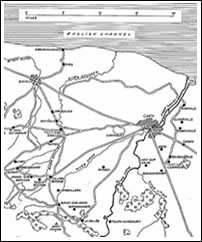
On D-Day, June 6, 1944, an Allied force led by General Dwight D. Eisenhower launched the greatest amphibious invasion of all time against German defenses on the coast of Normandy, France.
Much training took place during the time before the Normandy landings, but in early May 1944 the Division moved to its assembly areas near the embarkation ports. The 22nd Armoured Brigade moved to the grounds of Orwell Park School, near Ipswich, Suffolk, where waterproofing of the tanks and other preparations for the invasion of Normandy were completed ready for embarkation at Felixstowe. Meanwhile, the 8th Hussars had moved to the south coast ready to embark from Gosport.
This timeline follows the journey of the 8th Hussars, who were the armoured reconnaissance regiment of the 7th Armoured Division, in North-West Europe 1944-45.
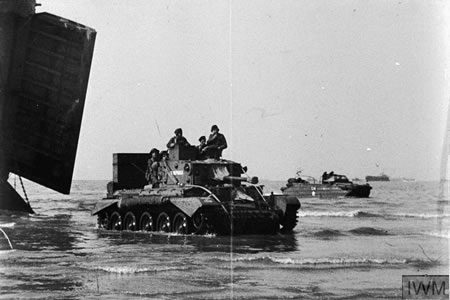
Normandy Campaign – 6 Jun 1944
On the 5th June 1944, the Division set sail for Normandy, with 4th CLY landing on the evening of 6th June 1944, on Gold Beach near Arromanches.
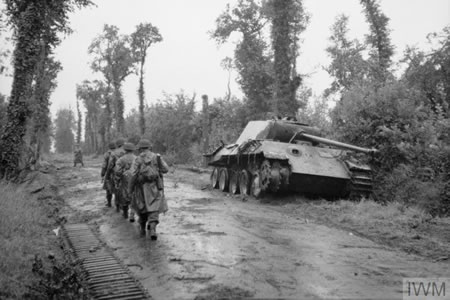
Villers-Bocage – 12-13 Jun 1944
The Division was ordered to advance and take the village of Villers-Bocage. The object of the advance was to be able to swing round an attack Caen from the west.
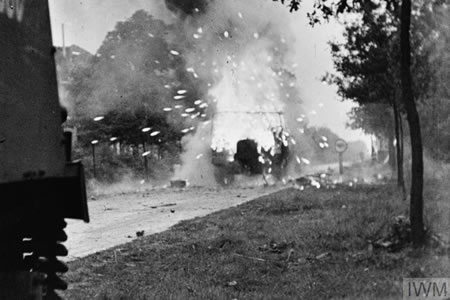
The Battle of the Brigade Box – 14 Jun 1944
With regular attacks being made by the Germans on all sides of the “box” the British high command decided that the Division should withdraw to straighten the front line. The Division now moved to positions east of Caumont, where it remained until the end of June.
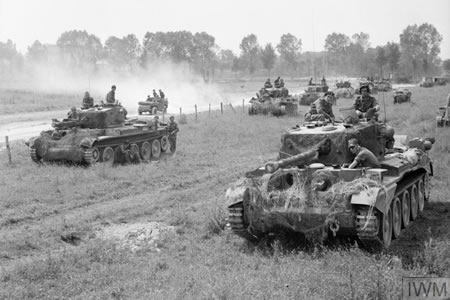
Operation GOODWOOD – 18-20 Jul 1944
Operation GOODWOOD was the largest tank battle fought during the North-West Europe 1944-45 campaign which resulted in the final capture of the French town of Caen and the attrition of German reserves, particularly the panzer forces.
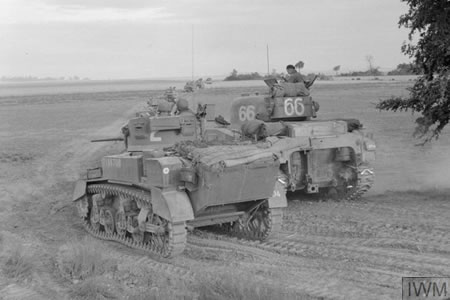
Operation SPRING – 29 Jul 1944
This was in support of the 2nd Canadian Corps, as a combined infantry and tank assault down the main Caen-Falaise road, being effectively an extension of Operation GOODWARD.
The attacked started on 29th July with 2nd Canadian Division on the right flank, with 7th Armoured Division supporting 3rd Canadian Division, which were heading for Verrieres.
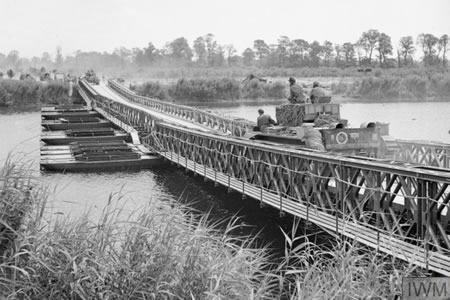
Operation BLUECOAT – 29 Jul – 6 Aug 1944
By July 1944, any prospect of the Germans repelling the invasion of North West France had vanished. In support of the long-awaited breakout, Montgomery ordered Operation BLUECOAT, eschewing the heavily-defended area around Caen in favour of a drive southward to the west of Caen.
The British pushed the front line back by eight miles and had seized the German dominated high ground south of Caen.
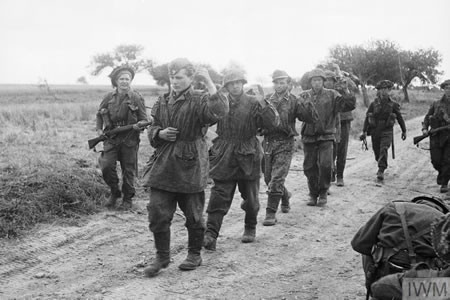
Breakout to The Seine – 15-28 Aug 1944
On 15th August, while the Falaise Pocket was still being closed, the Division moved to join the 1st Canadian Army, for an advance on the Seine, a distance of about 75 miles.
With the German front collapsing 7th Armoured Division was on the move again, sweeping through the campagne countryside to that of Picardy. By the evening on 28th August, the Division reached the Seine by the Foret de Bretonne.
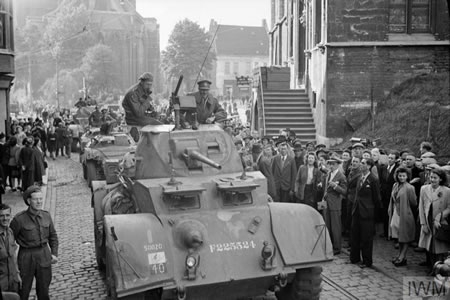
The Liberation of Ghent – 5 Sep 1944
At dawn on 5 September the leading elements of the division entered the city from the east. They then fought off attacks by roving groups of retreating Germans. In spite of some opposition from snipers and pockets on infantry by 20:00hrs that day the bulk of the Division had entered Ghent and its tanks were parked outside the Town Hall.
During the rest of September the Division was engaged in mopping up operations in Belgium and was not involved in ‘Operation MARKET-GARDEN’, the airborne attack on Arnhem, Eindhoven and Nijmegen.
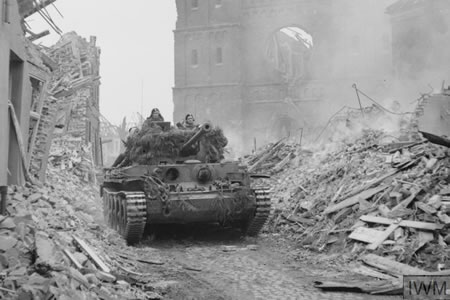
Clearing the Maas – 22-29 Oct 1944
At the end of October, the Division was ordered to clear the enemy away from the Maas and advance on Emelhuen. This was a distance of about 30 miles, through thickly wooded country, which gave way to polder country, with large fields surrounded by dykes.
On the first day the 8th Hussars lost 8 tanks, with the Division suffering 60 casualties. The Division moved along banks of the Maas, still meeting pockets of resistance, advancing for a week in total. This operation had cost 22 tanks and over 100 men.
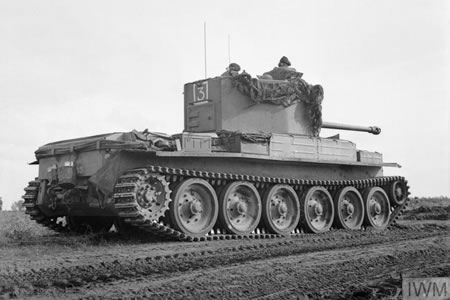
Operation BLACKCOCK – 13-26 Jan 1945
Having wintered in Holland, it was time to start clearing the Germany Army from the west bank of the River Roer. This operation started on 13th January 1945. It was to be a purely infantry operation as it involved a cross canal assault, but the armour would be ready to move forward and support them.
Gradually, the Germans withdrew to the Roer, covering their retreat with machine gun nests and mines, by the end of January ‘Operation BLACKCOCK’ was deemed a success.
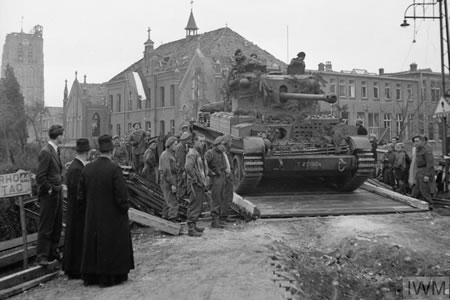
The Crossing of the Rhine – 23-27 Mar 1945
On the night of 23 March, Operation PLUNDER saw 2nd Army crossing the Rhine along a 12 mile front, with the Canadian 1st Army in the rear.
The first wave across the river used armoured amphibious vehicles and tanks fitted with flotation devices. Three days later on the morning of 27th March the Division crossed the Rhine.
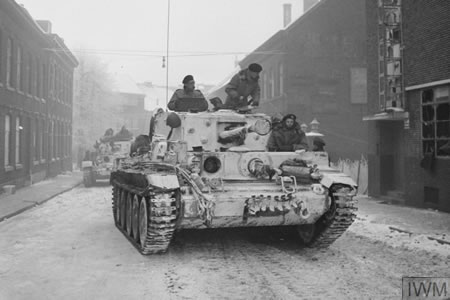
Teutoberger Wald to The Weser – 3-12 Apr 1945
Before the Division could reach its final objective, of Hamburg, it would have to cross the Dortmund-Ems Canal, running southeast from Rheine. Beyond the canal was a natural area of defence in the Teutoburger Wald, a wooded area on an escarpment 25 miles long and a mile wide.
Defending this area were the Hitler Youth Hanover Cadet school and their highly skilled instructors.
Many of them were good shots and they specialised in snipping at tank commanders and platoon sergeants. To assist them in their defence the Cadets had all the latest weapons and ridge gave them a perfect observation platform, with the wood providing excellent concealment.
Many of them fought to the death, rather than surrender.
In the face of the fanatical resistance the Division was ordered to disengage and bypass the opposition.
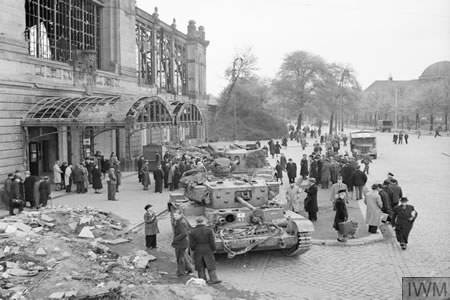
The Final push to Hamburg – 12 Apr – 1 May 1945
From crossing the Weser to the the surrender of Hamburg on the 1st of May by General Woltz to the 7th Armoured Division took just under three weeks of fast-paced fighting and liberation.
For the next two months the Division stayed in the Hamburg area sorting out prisoners, helping to clear up the mess in the city and dealing with the tens of thousands of displaced persons, how roaming the ruins of Germany.
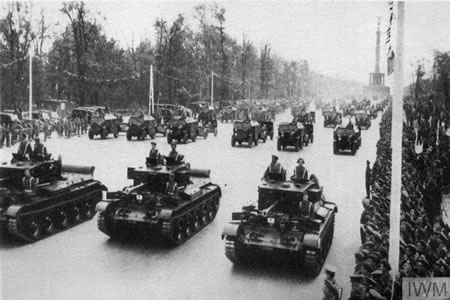
Berlin – Jul 1945
In July 1945 the Division was directed to move to Berlin, firstly to join the Occupation Forces there, and secondly to take part in the great Victory Parade through the city on 21st July.
At 10am on 21st July 1945 the guns of ‘J (Sidi Rezegh) Battery, 3rd RHA, fired the salute to signal the start of the ‘End of the War Parade’.
The fact that the 7th Armoured Division were given such a significant role in the parade was a fitting epitaph to a formation that had fought its way from the Desert to the heart of Nazi Germany.


